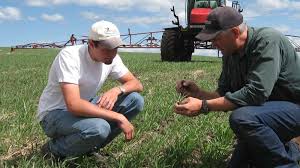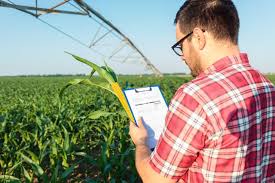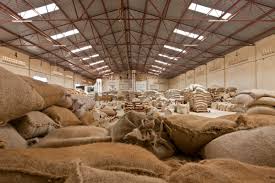Agricultural economics is the study of how agricultural resources are used and managed. It combines economic principles with agricultural practices to improve productivity and sustainability. This article explores the fundamental concepts of agricultural economics and its significance in society.
Agricultural economics examines the production, distribution, and consumption of agricultural goods and services. It analyzes how resources such as land, labor, and capital are utilized in agriculture.
Understanding agricultural economics is crucial for farmers, policymakers, and businesses involved in the agricultural sector.
1. Definition: Agricultural economics focuses on the economic aspects of agriculture, including farm management, agricultural policy, and rural development.
2. Importance: It helps farmers make informed decisions about resource allocation, production techniques, and marketing strategies, ultimately improving their livelihoods.
The Role of Agricultural Economics in Society
Agricultural economics plays a vital role in shaping agricultural practices and policies that affect food production and rural development. Here are some key contributions:
1. Food Security: Agricultural economics helps identify strategies to enhance food production, ensuring that populations have access to sufficient and nutritious food.
2. Rural Development: By analyzing agricultural practices, agricultural economics supports the development of rural areas, creating jobs and improving infrastructure.
3. Policy Formulation: Agricultural economists provide valuable insights for policymakers, helping them develop effective agricultural policies that promote sustainability and economic growth.
4. Environmental Sustainability: Research in agricultural economics addresses environmental concerns, guiding practices that minimize the negative impacts of agriculture on ecosystems.
5. Global Trade: Agricultural economics informs trade policies and agreements, helping countries maximize their agricultural exports while ensuring fair trade practices.
Basic Principles of Agricultural Economics

Understanding the basic principles of agricultural economics is essential for effective decision-making in agriculture. Here are some fundamental concepts:
1. Opportunity Cost: This principle states that the true cost of any choice is the value of the next best alternative foregone. Farmers must consider what they give up when choosing one crop over another.
2. Marginal Analysis: This involves comparing the additional benefits of an action to the additional costs. Farmers use marginal analysis to determine the optimal level of production or resource use.
3. Elasticity: Elasticity measures how responsive the quantity demanded or supplied is to changes in price. Understanding elasticity helps farmers predict how price changes will affect their sales and production decisions.
4. Diminishing Returns: This principle states that as more of a resource is added (e.g., labor or fertilizer), the additional output produced will eventually decrease. Farmers must find the right balance to optimize productivity.
5. Market Structures: Agricultural markets can be perfectly competitive, monopolistic, or oligopolistic. Understanding these structures helps farmers navigate pricing and competition in their markets.
Supply and Demand in Agriculture
Supply and demand are fundamental concepts in agricultural economics that influence prices and production levels. Here’s how they operate in agriculture:
1. Demand for Agricultural Products: Demand is influenced by factors such as consumer preferences, income levels, and the price of substitute goods. For instance, if the price of beef rises, consumers may shift to purchasing chicken instead.
2. Supply of Agricultural Products: Supply depends on factors such as production costs, technology, and weather conditions. For example, a drought can reduce crop yields, leading to a decrease in supply.
3. Market Equilibrium: The point where supply and demand intersect is known as the market equilibrium. At this point, the quantity of goods supplied equals the quantity demanded, determining the market price.
4. Price Fluctuations: Agricultural prices can be volatile due to seasonal changes, weather events, and global market conditions. Farmers must be aware of these fluctuations to make informed decisions.
5. Policy Interventions: Governments often intervene in agricultural markets to stabilize prices, support farmers, or ensure food security. Understanding these policies helps farmers navigate market dynamics.
Cost-Benefit Analysis in Farming
Cost-benefit analysis is a critical tool in agricultural economics that helps farmers evaluate the financial viability of their decisions. Here’s how it works:
1. Definition: Cost-benefit analysis involves comparing the costs of a decision or investment with the expected benefits to determine its feasibility.
2. Identifying Costs: Costs can be categorized as fixed (e.g., land, equipment) and variable (e.g., seeds, labor). Identifying all relevant costs is essential for accurate analysis.
3. Estimating Benefits: Benefits may include increased yields, higher prices for products, or savings from improved practices. Estimating these benefits helps determine the potential return on investment.
4. Break-even Analysis: This analysis identifies the point at which total costs equal total revenues. Understanding the break-even point helps farmers assess the risks associated with their decisions.
5. Making Informed Decisions: By conducting a cost-benefit analysis, farmers can make informed choices about investments, production techniques, and marketing strategies, ultimately improving their profitability.
Read Also : Complete Guide on Treatment of Livestock Diseases
Agricultural Policy and Its Impact

Agricultural policy refers to government actions that influence agricultural production, distribution, and consumption. These policies can significantly impact farmers, consumers, and the economy as a whole. Here are some key aspects:
1. Price Support Programs: Governments may establish price support programs to stabilize farm incomes by setting minimum prices for certain crops. This can help farmers maintain their livelihoods during price fluctuations.
2. Subsidies: Agricultural subsidies are financial aids provided to farmers to encourage production and lower consumer prices. While they can support farmers, they may also lead to market distortions and trade disputes.
3. Food Security: Agricultural policies often aim to ensure food security by promoting domestic production and managing imports. This helps to stabilize food supply and prices.
4. Environmental Regulations: Policies may include regulations that promote sustainable farming practices and protect natural resources. These regulations help mitigate the environmental impact of agriculture.
5. Research and Development Funding: Governments often invest in agricultural research to promote innovation and improve productivity. This funding supports the development of new technologies and practices.
The Economics of Crop Production
Understanding the economics of crop production is crucial for farmers and agricultural stakeholders. Here are the key elements:
1. Cost of Production: This includes all expenses incurred in the production process, such as seeds, fertilizers, labor, and equipment. Knowing these costs helps farmers assess profitability.
2. Yield Optimization: Farmers aim to maximize crop yields by selecting the right seeds, employing effective cultivation practices, and managing inputs wisely. Higher yields increase revenue and profitability.
3. Market Prices: Crop prices fluctuate based on supply and demand dynamics. Understanding market trends helps farmers make informed decisions about what to plant and when to sell.
4. Risk Management: Farmers face various risks, including weather events, pests, and market fluctuations. Effective risk management strategies, such as crop insurance and diversification, help mitigate these challenges.
5. Technological Advancements: Innovations in agriculture, such as precision farming and biotechnology, enhance productivity and efficiency. Farmers who adopt these technologies can improve their competitiveness.
Livestock Economics: An Overview
Livestock economics focuses on the production and management of farm animals for food, fiber, and other products. Here are some essential aspects:
1. Production Costs: Raising livestock involves various costs, including feed, veterinary care, housing, and labor. Understanding these costs is vital for profitability.
2. Market Demand: Consumer preferences and dietary trends influence the demand for livestock products. Awareness of these trends helps farmers make informed decisions about production levels.
3. Breeding Practices: Effective breeding programs can enhance livestock quality and productivity. Farmers must consider genetics, health, and reproduction to optimize their herds.
4. Environmental Impact: Livestock production has environmental implications, including greenhouse gas emissions and land use. Sustainable practices, such as rotational grazing and manure management, help reduce this impact.
5. Animal Welfare: Increasing consumer awareness of animal welfare has led to changes in production practices. Farmers must balance profitability with ethical considerations to meet consumer expectations.
Market Structures in Agriculture
Agricultural markets can vary significantly in structure, affecting pricing, competition, and profitability. Here are the main market structures:
1. Perfect Competition: In perfectly competitive markets, numerous small farmers sell identical products. Prices are determined by supply and demand, leaving little control for individual farmers.
2. Monopolistic Competition: This structure features many sellers offering differentiated products. Farmers can influence prices to some extent through branding and quality differentiation.
3. Oligopoly: In an oligopolistic market, a few large firms dominate production. These firms can influence prices and market conditions, creating challenges for smaller farmers.
4. Monopoly: A monopoly occurs when a single producer controls the entire market for a product. This can lead to higher prices and reduced competition, negatively impacting consumers.
5. Vertical Integration: This involves combining different stages of production and distribution within a single company. Vertical integration can enhance efficiency and profitability by reducing transaction costs.
Read Also: The Most Lucrative between Production of Fish Fingerlings or Raising them to Table Size
International Trade in Agricultural Products

International trade plays a crucial role in agricultural economics, allowing countries to exchange goods and services. Here are key considerations:
1. Comparative Advantage: Countries specialize in producing certain agricultural products based on their resources and climate, leading to increased efficiency and trade.
2. Trade Policies: Tariffs, quotas, and trade agreements influence the flow of agricultural products between countries. Understanding these policies is essential for farmers and businesses engaged in international trade.
3. Export Opportunities: Countries with surplus agricultural production can benefit from exporting their products, improving their trade balance and boosting their economy.
4. Import Dependency: Some countries rely on imports to meet their food needs. Understanding global supply chains helps policymakers ensure food security and stability.
5. Market Access: Gaining access to international markets is crucial for farmers. Barriers to trade, such as regulations and tariffs, can affect their ability to compete globally.
Agricultural Finance and Credit Systems
Agricultural finance refers to the funding and financial services available to farmers and agribusinesses. Understanding agricultural finance is vital for effective farm management. Here are some key components:
1. Sources of Agricultural Finance: Farmers can access funding from various sources, including commercial banks, cooperatives, microfinance institutions, and government programs. Each source has its advantages and disadvantages.
2. Credit Systems: Credit systems provide farmers with loans to purchase inputs like seeds, fertilizers, and equipment. Understanding different types of loans, such as short-term and long-term loans, is essential for farmers.
3. Interest Rates: Interest rates significantly impact borrowing costs. Farmers should compare rates from different lenders and consider the terms and conditions before taking loans.
4. Financial Management: Effective financial management involves budgeting, record-keeping, and monitoring cash flow. Farmers must track their income and expenses to ensure profitability and sustainability.
5. Risk Assessment: Understanding and managing financial risks is crucial. Farmers should consider factors such as market fluctuations, weather conditions, and input prices when making financial decisions.
Environmental Economics in Agriculture
Environmental economics focuses on the relationship between agricultural practices and environmental impacts. It aims to find sustainable solutions that balance agricultural productivity with environmental protection. Here are some key aspects:
1. Resource Management: Effective management of natural resources, such as water and soil, is essential for sustainable agriculture. Farmers should adopt practices that conserve these resources.
2. Externalities: Agricultural activities can lead to externalities, which are unintended consequences affecting third parties. For example, pesticide runoff can harm nearby ecosystems. Understanding these impacts is vital for developing sustainable practices.
3. Valuation of Ecosystem Services: Environmental economics emphasizes the importance of valuing ecosystem services, such as pollination and soil fertility. Farmers should recognize the benefits these services provide and integrate them into their farming practices.
4. Sustainable Practices: Implementing sustainable practices, such as organic farming and agroforestry, can enhance productivity while minimizing environmental impacts. These practices contribute to long-term ecological health.
5. Policy Implications: Environmental economics informs policy decisions aimed at promoting sustainable agriculture. Governments can develop incentives and regulations that encourage environmentally friendly practices among farmers.
The Role of Technology in Agricultural Economics
Technology plays a pivotal role in improving agricultural productivity and efficiency. Here are some key areas where technology impacts agricultural economics:
1. Precision Agriculture: Technologies such as GPS and remote sensing allow farmers to monitor and manage their fields more effectively. Precision agriculture enhances resource use efficiency and crop yields.
2. Data Analytics: Data analytics tools help farmers make informed decisions based on market trends, weather patterns, and soil conditions. Access to data enables farmers to optimize their operations.
3. Biotechnology: Advances in biotechnology, such as genetically modified organisms (GMOs), can enhance crop resilience and productivity. Understanding the economic implications of these technologies is essential for farmers.
4. Automation: Automation technologies, such as drones and robotic systems, reduce labor costs and improve efficiency in agricultural operations. These technologies allow farmers to focus on strategic decision-making.
5. E-commerce and Marketing: Online platforms enable farmers to market their products directly to consumers, increasing their profit margins. Understanding e-commerce dynamics is crucial for modern agricultural businesses.
Challenges Facing Agricultural Economists Today
Agricultural economists face several challenges in their efforts to promote sustainable and efficient agricultural practices. Here are some key challenges:
1. Climate Change: Climate change poses significant threats to agriculture, including altered weather patterns and increased frequency of extreme events. Agricultural economists must develop strategies to mitigate these impacts.
2. Globalization: The globalization of agricultural markets creates both opportunities and challenges. Agricultural economists must analyze the effects of global trade policies and competition on local farmers.
3. Resource Scarcity: Increasing demand for food and limited natural resources create challenges for sustainable agriculture. Economists must find innovative solutions to balance production and conservation.
4. Technological Adoption: While technology has the potential to enhance productivity, some farmers may be hesitant to adopt new practices. Agricultural economists need to address barriers to technology adoption, such as access to capital and training.
5. Policy Uncertainty: Changes in government policies can impact agricultural economics significantly. Agricultural economists must navigate these uncertainties and advocate for policies that support sustainable practices.
Do you have any questions, suggestions, or contributions? If so, please feel free to use the comment box below to share your thoughts. We also encourage you to kindly share this information with others who might benefit from it. Since we can’t reach everyone at once, we truly appreciate your help in spreading the word. Thank you so much for your support and for sharing!
Read Also: What You Need to Know About Osteospermum
Frequently Asked Questions
We will update this section soon.

